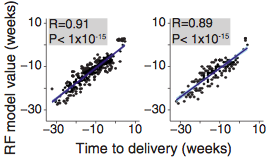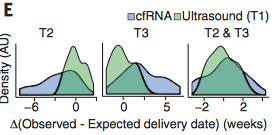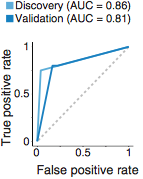博文
cfRNA用于预测早产
||
文章:Noninvasive blood tests for fetal development predict gestational age and preterm delivery
杂志:Science
年份:2018
第一:cfRNA胎龄的预测
We then built a random forest model to predict time from sample collection until delivery, using cfRNA measurements as the primary features. (建模方法)
We trained and validated this model using data from the Danish cohort from 21 women (n = 306 blood samples) for training, and from 10 women (n = 215 blood samples) for validation.(样本数量)
During training, we applied best-subset selection with 10-fold cross-validation repeated 10 times (see supplementary materials) to identify nine cfRNAs that are specific to the placenta (CGA,CAPN6, CGB, ALPP, CSHL1, PLAC4, PSG7, PAPPA, and LGALS14) and together provided equivalent predictive power to the full panel of 51 measured cfRNAs. (10折交叉验证的策略,得到9个marker)
Our model’s predictions agreed with observed values for both training (Pearson correlation r = 0.91, P < 10−15) and validation sets (r = 0.89, P < 10−15). (模型的预测效果)

In this study, for all 31 Danish women, cfRNA estimates of gestational age averaged over a given trimester fell within 14 days of the observed gestational age at delivery with 32% (T2), 23% (T3), and 45% (T2 and T3) accuracy, as compared to 48% (T1) for ultrasound. Our results are thus generally comparable to ultrasound measurements, can be performed throughout pregnancy, and do not require a prioriphysiological knowledge such as the woman’s last menstrual period. (模型预测结果的准确性)

第二:cfRNA早产的预测
To identify cfRNA transcripts that might be able to discriminate a spontaneous preterm delivery from a full-term delivery, we performed unblinded RNA sequencing (RNA-seq) on plasma-derived cfRNA collected from women who delivered at full term (n = 7) and preterm (n = 8) in a preterm-enriched cohort (Pennsylvania). Analysis of RNA-seq data indicated that 38 genes could separate full-term from preterm births with statistical significance (P < 0.001). We then created a PCR panel to measure the 38 cfRNAs identified by RNA-seq and other immune and placental genes. We confirmed that the differential expression observed using RNA- seq was also observed with quantitative reverse transcription PCR (qRT-PCR) (r = 0.72, P < 10−15). (特征筛选,基因的挑选)
We then developed a classifier to identify women who are at risk of preterm delivery and found that using the top seven cfRNAs from the panel (CLCN3, DAPP1, PPBP, MAP3K7CL,MOB1B, RAB27B, and RGS18) [false discovery rate (FDR) ≤ 5%, Hedges’ g ≥ 0.8] in unique combinations of three accurately classified 6 of 8 preterm samples (75%) and misclassified only 1 of 26 full-term samples (4%) from the Pennsylvania and Denmark cohorts, with a mean area under the curve (AUC) of 0.86 (Fig. 3C). In validation using a preterm-enriched independent cohort (the Alabama cohort), the test accurately classified 4 of 5 preterm samples (80%) and misclassified 3 of 18 full-term samples (17%) (Fig. 1), with a mean AUC of 0.81. (模型的效果)
� �
�
未来需要完善的地方:
1)样本的类型民族更加多元化;
2)早产的样本类型更加多元化,不单是临床判断的风险样本。
https://blog.sciencenet.cn/blog-306699-1119136.html
上一篇:metagenome可视化工具Krona
下一篇:Best practices for analysing microbiome的个人理解